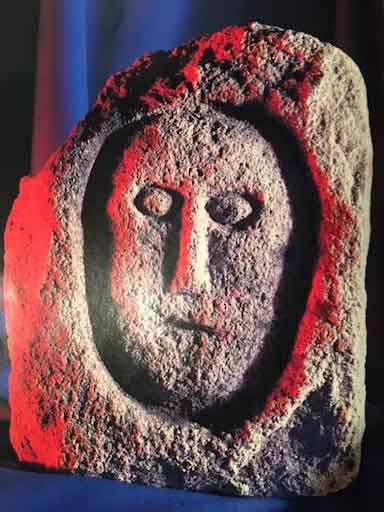Who can be trusted to mark the path in these troubled times where there seem to be no answers and no way forward. I’m casting my lot with Hermes, that psychopomp who leaves stones to mark crossroads for travelers and who leads journeyers into the underworld and back again.
Jung, in Secret of the Golden Flower, speaks to the relevance of symbol. “The collective unconscious does not understand the language of the conscious. Therefore, it is necessary to have the magic of the symbol which contains those primitive analogies that speak to the unconscious. The unconscious can be reached and expressed only by symbols, which is the reason why the process of individuation can never do without the symbol. The symbol is the primitive expression of the unconscious, but at the same time it is also an idea corresponding to the highest intuition proceeded by consciousness.”
 I have chosen, for now, the ordinary stone as a symbol of the still point, time slowed down, ancient and enduring, a place of rest and solace in times of personal and collective crisis. It is through the image that we begin to allow an expanding vision that emerges deep within the human soul. Within that still place the image quietly mediates heaven and earth allowing something new to emerge.
I have chosen, for now, the ordinary stone as a symbol of the still point, time slowed down, ancient and enduring, a place of rest and solace in times of personal and collective crisis. It is through the image that we begin to allow an expanding vision that emerges deep within the human soul. Within that still place the image quietly mediates heaven and earth allowing something new to emerge.
There is a story of a woman who is following the Sufi path. She dreams of bringing her psychological disturbances to her teacher. Frustrated at the teacher’s seeming disinterest she is taken aback when the teacher takes a dark stone from her pocket which glows bright and pulses with light. She is told to take the stone out from time to time and look at it. The Lover and the Serpent, Vaughn-Lee
The dark stone, which “glows bright” and “pulses with light,” is undoubtedly the philosopher’s stone, the goal of the inner work. It is always in our possession even though we may forget it from time to time. In alchemy, the Philosophers shed tears over the stone and von Franz states that the stone sent by God was the starting-point and the goal of the alchemical opus, that place of suffering where the inner work often begins.
“I tilled the sorrows of the stone, until love found a way to breathe life into this feeble heart and lift this mortal veil of tears” are the words from the song called “Dante’s Prayer.” The stone is all around us, the ancient cooling of the earth itself. It carries mountains and rivers; it is the foundation of the buildings that house us; it is the ancient altars on which sacrifices of petition and atonement were performed. It was present before any human sorrow and long after humans have ceased to exist. The stone is in many ways a mystery, interweaving both physically with the earth and symbolically with the human psyche. In the preface to his beautiful book, Talk to a Stone, Tetsuzan Shinagawa writes: “Even a stone will respond to you if you approach with love, call out, and talk to it.” Imagine, for a moment, you are holding a stone in your hands. Hold it, feel it, love it, flow into and through it. And, as the 17th century Japanese poet Matsuo Basho suggests, “We begin our journey of transformation in quietness and stillness, letting the stone absorb the noise of our everyday life.”
Von Franz quotes in Myth in Our Time, “When the Tao, the meaning of the world and eternal life are attained, the Chinese say: “Long life flowers with the essence of the stone and the brightness of gold.” Jung comments….”This essence of the stone has grown out of the initial fiery magma. This fiery magma is a metaphor for the cauldron of the self out of which the inner stone forms which then must be worked and shaped in the journey of individuation. Indeed, this is not just a necessary goal for each one of us individually; it is a critical goal in present history for the entire human collective.”
The power of the stone to transform human nature and, hopefully, the collective, is depicted with a beautiful simplicity within a children’s story by Nathaniel Hawthorne. One’s first experience of the Self is generally in projection. This story is of a boy who sees the divine image in stone, one in which he spends his entire life searching for.
The hero is named, appropriately, “Ernest.” The valley in which he lives is a well-populated cross-section of the human adventure, neither better nor worse than human collectives everywhere. The valley is hedged-in with rocky mountains, and, from down in the valley, a person looking up at a certain out-cropping of rock, will see the outlines of a majestic human countenance. The face like countenance projects something noble, intelligent, tender, and enormously kind. Ernest, even as a child, finds this combination lacking in his fellow valley citizens, and he longs to see the fulfillment of the ancient prophecy that someday a paragon will appear in the village who both resembles the stone face on the mountain and who possesses its projected qualities. As a somewhat solitary and pensive child, Ernest spent hours gazing upon the face of stone. He reached out with his heart and asked it to become his teacher, a role it retained throughout his long life. The years went by and various luminaries took center stage, but none came close to capturing the qualities of the face. In Hawthorne’s words, “The sublimity and stateliness, the grand expression of a divine sympathy, that illuminated the mountain visage and etherealized its ponderous granite substance into spirit, might here be sought in vain.” An old man now, Ernest is still looking for the prophesized paragon, (face in the stone.) He alone in the valley is unaware what the other residents now know, that the stone face with its sublime qualities has sculpted the face of Ernest and taken up residence within him.
In Dimensions of the Psyche, von Franz says of the process of individuation, “Experientially, it is as though something divine and creative intervenes in the life of the individual and indeed in a personal and individual fashion. We have the feeling that something is watching us, something that we do not see – perhaps that ‘great man’ in one’s heart, who communicates his intensions to us in dreams.”
It seems to me that unconsciously we all are drawn to the power and meaning of the stone or still point, long before we might become cognizant of a journey of transformation within. This, of course, is the thrust of Hawthorne’s story.
Jungian analyst Edward Edinger imagined the troubled times that we are now living when he wrote of earth-shaking collective phenomenon. “It is manifesting itself in international relations; in the breakdown of the social structure of Western civilization; in political, ethnic, and religious groupings; as well as within the psyches of individuals.” Towards the end of his life, Jung, himself, was not particularly optimistic about our future, “Too much pointed toward war, mass psychosis, and impending disaster.” Yet all is not hopeless. If an adequate number of individuals become conscious…our civilization can renew itself and survive…”A person can only be creative in connection with the “ordinary man” within himself, the inner stone face of which Hawthorne wrote so perceptively. So, says Jung, “Instead of waiting like a herd of sheep huddling together from fear until some unauthorized figure presses the atomic button, we can actually do something. We can begin to cut and polish the inner stone of the Self, what the alchemists called the lapis, a symbol of the free, mature, and responsible individual.”
And returning to lines from the song, Dante’s Prayer:
“When the dark wood fell before me – and all the paths were overgrown –
When the priests of pride say there is no other way – I tilled the sorrows of stone.
…Breathe life into this feeble heart – lift this veil of fear
Take these crumbled hopes, etched with tears – we’ll rise above these earthly cares.”
And, finally, Jung’s beautiful dream just before he died, as von Franz writes in, Jung, His Myth in Our Time. “He saw a great round stone in a high place, a barren square, and on it were engraved the words: And this shall be a sign unto you of Wholeness and Oneness. Then he saw many vessels to the right in an open square and a quadrangle of trees whose roots reached around the earth and enveloped him, and among the roots golden threads were glittering.”
With stillness and imagination we can traverse the unknown path as Zen-Buddhist D.T. Suzuki writes: “The awakening is really the discovery or excavation of a long-lost treasure…this is homecoming. This is the seeing of ones own ‘primal face,’ which one has seen even before birth. The unconscious which has been lying quietly…now raises its head and announces its presence through consciousness.”
Anne Pickup is a licensed psychotherapist in D.C. and Maryland with a Masters Degree in Marriage and Family Therapy. She received her Diploma in Analytical Psychology from the C.G. Jung Institute of Los Angeles. She is a founding member of the C.G. Jung Study Center of California, past president of the Philadelphia Association of Jungian Analysts, and current president of the Jungian Analysts of the Washington Area. She is a member of the Inter-Regional Society of Jungian Analysts, and is secretary of the Kairos film project; preserving Jung.
Anne has lectured and taught in N.Y. Calif., and D.C. on themes of separation and loss. She lives in V.A. and has a private practice in D.C.
